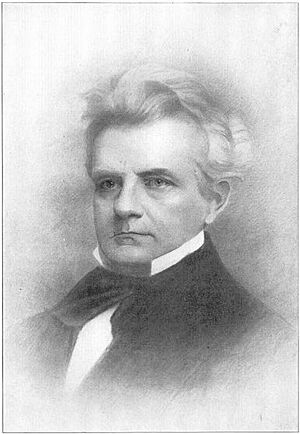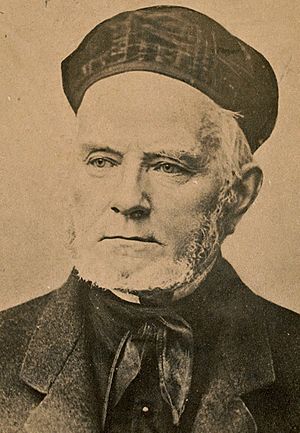Lowell Mason facts for kids
Lowell Mason (born January 8, 1792 – died August 11, 1872) was an important American musician and banker. He became a leading figure in church music during the 1800s. Lowell Mason wrote over 1600 hymn tunes (melodies for hymns), many of which are still sung today. His most famous works include the arrangement of Joy to the World and the tune Bethany, used for the hymn Nearer, My God, to Thee. Mason also wrote the music for Mary Had A Little Lamb. He is widely recognized for bringing music education into American public schools. He is seen as the first major U.S. music educator. However, some also criticize him for changing the strong tradition of church music that existed before his time.
Contents
Lowell Mason's Early Life
Mason was born and grew up in Medfield, Massachusetts. At age 17, he became the music director at First Parish Church. His childhood home was saved in 2011 and moved to a town park. There's an effort to turn it into a museum and music education center.
He spent his early adult years in Savannah, Georgia. He first worked in a dry-goods store, then at a bank. Mason loved music and studied with a German teacher named Frederick L. Abel. He soon began writing his own music. He also became a leader in music at the Independent Presbyterian Church. He was their choir director and organist. Under his guidance, his church started the first Sunday school for Black children in America. This was at the church now known as Historic First Bryan Baptist Church in Savannah.
Publishing a Hymnal
Mason decided to create a hymnal (a book of hymns). He wanted to use tunes from famous European composers like Haydn, Mozart, and Beethoven. It was hard for him to find someone to publish his work. Finally, the Handel and Haydn Society of Boston published it in 1822. This society was one of the first American groups focused on classical music. Mason's hymnal became very popular. He first published it without his name. He felt his main job was banking and didn't want to hurt his career.
Mason's Time in Boston
In 1827, Mason moved to Boston. He continued his banking job for a while. From 1829 to 1831, Mason was the choirmaster and organist at Park Street Church. He eventually became a music director for three different churches. One of these was the Hanover Street church, where the famous abolitionist Lyman Beecher was pastor. An abolitionist was someone who wanted to end slavery.
Mason became a very important person in Boston's music scene. He was president of the Handel and Haydn Society. He also taught music in public schools. In 1833, he helped start the Boston Academy of Music. From 1838 to 1841, he was the music superintendent for the Boston school system. In the 1830s, Mason set the nursery rhyme "Mary Had a Little Lamb" to music. In 1845, he left his job with the Boston school committee.
Later Years in New York
In 1851, at age 59, Mason stopped his music work in Boston. He moved to New York City. His sons, Daniel and Lowell Jr., had started a music business there. In December 1851, he traveled to Europe. During his trip in 1852, he became very interested in congregational singing. This is when everyone in the church sings together. He especially liked the singing in German churches, like the Nikolaikirche in Leipzig.
After returning to New York City, Mason became the music director for the Fifth Avenue Presbyterian Church in 1853. The church had just finished building a new church. He immediately removed the choir and orchestra. He installed an organ, and his son William became the organist. During his time there, which lasted until 1860, he made the congregational singing so good that the church was known for it. In 1859, Mason and others published the "Sabbath Hymn and Tune Book." This part of his career had a lasting impact on American church music. Mason changed his mind about church members being unwilling to sing. He strongly encouraged everyone to sing. He removed all professional musicians except for the organist.
In 1855, the University of New York gave Mason a special degree. He received a doctor of music degree. This was the first music degree ever given by an American college.
In 1860, Mason retired to his home in Orange, New Jersey. He helped start Valley Congregational Church there. He was buried in Orange's Rosedale Cemetery.
Lowell Mason's Legacy
The editors of the Grove Dictionary of Music and Musicians have discussed Mason's influence. They note his focus on European classical music as a model for Americans. However, Mason is also praised for making European classical music popular in America. Before him, this type of music was rarely performed there. Since his time, the United States has become a place where classical music is enjoyed.
Some music experts believe that Mason's ideas about European music changed American church music. They think it stopped a lively tradition of American church music. This earlier music included great songs by composers like William Billings. In the early 1800s, shape note music was used to teach singing. Mason and his friends called this music "unscientific" and old-fashioned. They taught their views through new singing schools. These schools replaced the older ones from colonial times.
The music that Mason promoted was often simpler in rhythm. It also had less strong harmonies compared to earlier American sacred music. By making the soprano (highest) part the most important, it made other singing parts less interesting. Also, this new music often needed an organ for support. Organs were a business for the Mason family.
The older tradition of American sacred music moved to the rural South. It continued there in forms like Sacred Harp music. This type of music has become popular again. Americans and even Europeans are rediscovering this music from before Lowell Mason's time.
Despite these criticisms, Mason's achievements as a hymn writer were celebrated long after his death. In 1942, his 150th birthday was well-celebrated. A plaque was placed at his grave. A special service was held at the church he founded in Orange. It included performances of Mason's music. Organ pieces based on Mason's hymn tunes were specially written for the event. These were by T. Tertius Noble and Mason's grandson Daniel Gregory Mason. Later that evening, another concert of Mason's music took place at Union Theological Seminary in New York City.




